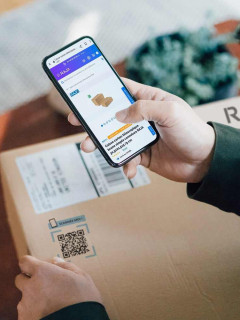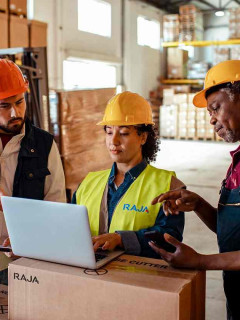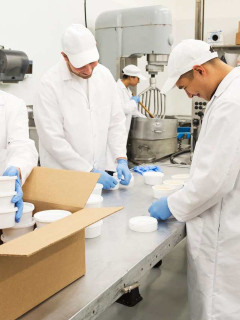As a logistics manager, you’re well aware that every product requires careful attention to the mode of transport you choose for it, as well as the packaging that will enable it to be delivered in good condition.
For temperature-sensitive products, this is even more the case – since the packaging of these goods throughout the supply chain can affect the health and safety of your customers!
Here’s a complete guide to refrigerated transport, to ensure that your deliveries are tailored to your goods and respect the cold chain.
For what types of product is refrigerated transport essential?
Not all goods need to be transported in refrigerated vehicles.
You will need this very specific type of transport if you intend to ship products that are not stable, i.e. whose integrity and quality may be jeopardised by failure to comply with the cold chain.
For example, refrigerated transport is crucial if you are shipping :
- Fresh, dry and frozenfood products
- Pharmaceutical products
- Cosmetics
- Chemical products (liquid or solid)
- Flowers and plants
- Alcoholic beverages
- Samples for microbiological analysis
| A short glossary of refrigerated transport
Here are a few terms you’ll find in the world of refrigerated transport, the definitions of which are important to know: Temperature-controlled transport refers to a method of refrigerated transport for products that need to be kept at a low temperature in order to preserve their quality. It is therefore a synonym for “refrigerated transport”.
|
What do the regulations say about temperature-controlled transport?
Goods requiring refrigerated transport are particularly fragile and, in the absence of temperature control, can deteriorate or even become dangerous for end customers. This is why temperature-controlled transport is particularly regulated, via two pieces of legislation that you can find out more about here.
The ATP Agreement (Agreement on the Transport of Perishable Foodstuffs)
The ATP agreement is a set of standards that vehicles transporting perishable goods must meet, and has been signed by almost 50 countries.
In France, under this agreement, CEMAFROID is responsible for issuing a certificate of conformity for vehicles. This certificate is presented when refrigerated vehicles are inspected.
To ensure that they comply with the standards of the ATP agreement, the vehicles first undergo a test at an ATP test station, to check their thermal characteristics. Then, once they have been in service for 6 and 9 years, they are retested at an authorised test centre. After 12 years, they must again pass an official ATP station to check that they are still suitable for refrigeration.
Note that ATP certification is not required for :
In these cases, isothermal packaging (as you will discover later in this article) may be sufficient to guarantee the integrity of the products and the safety of consumers. |
The hygiene package
The hygiene package brings together a set of European regulations setting standards for the hygiene of foodstuffs and animal feed.
Born out of recent food crises (such as mad cow disease, salmonella and spanghero), this package lays down the storage and transport conditions for these different types of foodstuffs.
It also defines the temperatures required for refrigerated transport:
- -18°C for frozen products
- -20°C for ice cream
- Between 2 and 4°C for fresh products whose freshness must be preserved
- +8° for fruit and vegetables
- +12° for wines
- +17° for chocolates and confectionery
Another element of the hygiene package is that all establishments working with perishable foodstuffs must implement a HACCP (Hazard Analysis Critical Control Points) programme. In concrete terms, this programme stipulates that companies responsible for refrigerated transport must identify, assess and control the risks associated with foodstuffs at all stages of the supply chain. In particular, they must have a system for monitoring the control of critical points in the cold chain, and strict verification processes.
The specifics of international refrigerated transport
If you export your products, you’ll be aware that the international transport of goods has its own special characteristics that need to be taken into account.
International refrigerated transport can be by road or air.
Agreements between the member countries of the European Union allow the free movement of dry and fresh goods within the EU. So if you’re shipping to these countries, your procedures are simplified, and the regulations exempt you from having to go through customs.
For other countries, the customs formalities (including invoices on dispatch) must be handled by your transport service provider to ensure a smooth passage through customs.
What does a refrigerated truck look like?
Let’s take a quick tour of a typical refrigerated truck.
This type of vehicle always has :
- Insulating walls, which prevent the products from being subjected to external temperature variations.
- Tools for regularly measuring the temperature of products, to ensure that the cold chain is maintained and respected. These may be probes or thermometers. These traceability systems must be reliable and available in the truck itself.
Beyond these similarities, there are different types of refrigerated container.
The different types of refrigerated vehicles
First of all, there is a difference between :
- An insulated vehicle, which has a body insulated over all its surfaces, made of expanded polystyrene or inflatable bags lined with insulating material. This body reduces heat exchange through the walls. This is also known as a “refrigerated box truck”.
- A refrigerated vehicle, fitted with a (non-mechanical) cooling device that adjusts the temperature inside the body.
- A refrigerated vehicle, equipped with a mechanical device (thermoregulator) capable of generating cold, which allows you to adjust the temperature inside the body. This is also known as a “truck with a refrigeration unit”.
- A heating vehicle, which raises the temperature inside the empty body and maintains it for at least 12 hours.
The ATP agreement also defines a typology of refrigerated trucks, according to the different cold classes that can be maintained:
- Class A vehicles keep the load between 0 and +12°.
- Class B vehicles keep the passenger compartment between -10 +12°.
- Class C vehicles keep the temperature between -20 and +12°.
What criteria should you use to choose your refrigerated transporter?
Would you like to use a service provider specialising in temperature-controlled transport, but don’t know where to start looking?
Keep the following six quality criteria in mind:
- Compliance with the regulatory framework. Make sure you ask them questions about their fleet of vehicles, and check that they pass the necessary ATP checks.
- Respect for the cold chain, depending on the type of product you want to ship.
- Appropriate delivery times. Depending on whether you’re delivering to retailers, manufacturers, restaurants or private individuals, you’ll choose between express delivery (D+1) or slower delivery, if possible within a time slot so that the recipient can take care of the cold chain themselves.
- Adapted to your delivery volume. The various carriers offer you the possibility of transporting parcels, pallets or shopping baskets.
- Training for carriers and drivers. They must be trained in loading and unloading procedures to avoid breaking the cold chain.
- Eco-responsibility. Check that the service provider you choose reduces its carbon footprint as much as possible during the refrigerated transport of goods. If the shelf life of your products allows it, also ask them if they can offer you local refrigerated transport solutions, suitable for last-mile delivery.
6 refrigerated transport companies to consider
Depending on your area of activity and where you want to ship your products, you’ll find a number of refrigerated transport companies.
Here are six to consider:
- Chronofresh. This is a Chronopost subsidiary offering temperature-controlled international and domestic transport. The company can provide express refrigerated transport, or plan a made-to-measure delivery. It also provides logistics platforms equipped with cold rooms for storing products and preparing orders prior to delivery.
- The STEF Group. This company delivers anywhere in France within 24 to 48 hours, and provides real-time tracking of operations on a dedicated digital platform. The carrier is also EcoVadis Gold certified, a guarantee of genuine eco-responsibility.
- The STG Group. A specialist in temperature-controlled transport, with over 30 platforms in France for the storage and transport of products sensitive to temperature variations, this group also takes care to be as environmentally friendly as possible, thanks to transport schemes to reduce journeys and eco-driving training for its drivers. Its objective: to reduce its greenhouse gas emissions by 20% by 2030.
- Étoile Routière. For refrigerated deliveries between Nantes and Paris, this temperature-controlled logistics specialist has a fleet of vehicles running on biofuel made in France, and designed to Euro VI standards.
- Frévial. This refrigerated transport company serves the whole of northern France.
- JLG Services. Based in Vannes, this company serves a large part of France.
The key equipment for your refrigerated deliveries
Whether regulations require you to use a refrigerated transport specialist, or whether you can deliver your products using a traditional carrier, here’s the equipment you’ll need to ensure the protection of your goods and the customer experience.
Insulated packaging
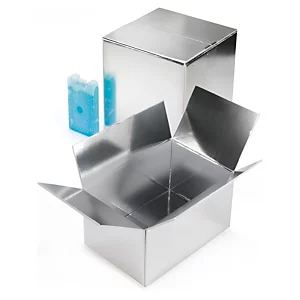 |
The Isostar® isothermal crate keeps your products at a temperature of +2°C to +8°C for at least 24 hours, depending on the number of cold accumulators you use. It is both protective and attractive, with its metallised polyethylene sheets. |
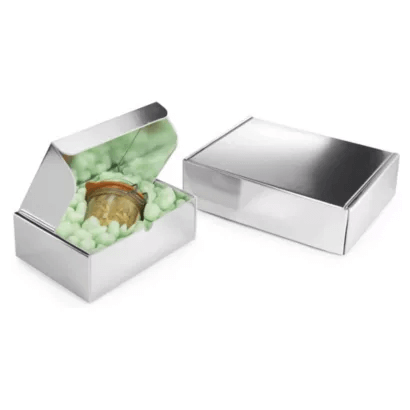 |
The Isostar® isothermal box keeps your products at a temperature of +2°C to +8°C for up to 12 hours, depending on the number of cold accumulators used. |
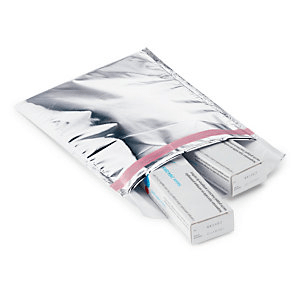 |
The isothermal bag with adhesive closure prevents your small products from thermal shock. They are also available with a zip closure. |
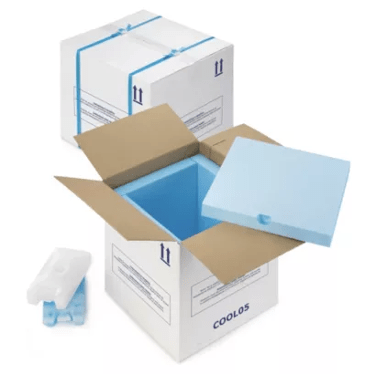 |
The Cool® isothermal cardboard box keeps goods at positive (+2/+8°C) or negative (-20°C) temperatures, even over long periods. Its box and panels are 100% recyclable. |
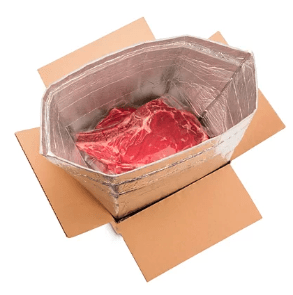 |
The Isopro® isothermal cardboard box keeps food products at a temperature of 0°C to +4°C for 24/48 hours, depending on the number of cold accumulators used. Its isothermal bag closes with a double fold. |
Cold accumulators
If you choose isothermal packaging, you’ll need to use appropriate cold accumulators to ensure that it maintains the desired temperature.
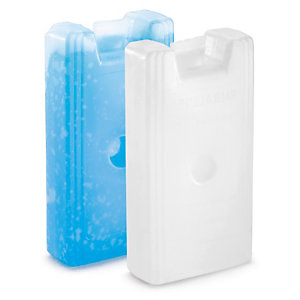 |
Rigid cold accumulators keeps products at a positive (0/+4°C and 2/+8°C) or negative (-20°C) temperature, and is reusable. |
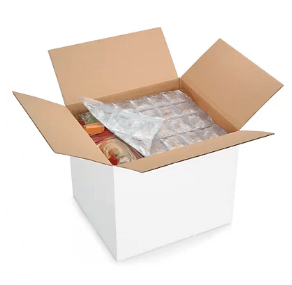 |
The flexible cold accumulator keeps products at a positive temperature (0/+4°C and 2/+8°C), and is reusable. Its flexible envelope adapts to the volume of your packaging. |
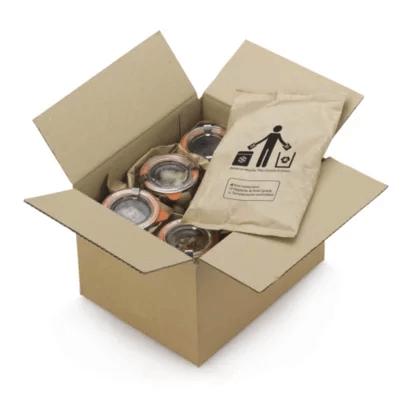 |
The flexible cold accumulator in a kraft cover bag keeps products at a positive temperature (+2/+8°C). It has a rigid envelope with a kraft outer cover, to give an eco-responsible look to your deliveries. |
Isothermal, thermal and/or insulating padding
Add a padding material suitable for refrigerated transport to further protect your products at the required temperatures.
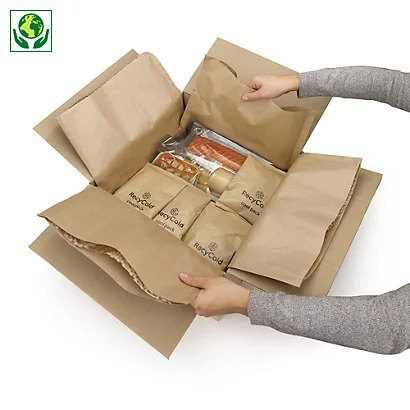 |
Recycold™ Climaliner RANPAK is 80% recycled and totally recyclable. It guarantees the protection of products from 10h to 48h with cold accumulators. It is flexible and lightweight, and fits easily into a kraft bag or cardboard box. |
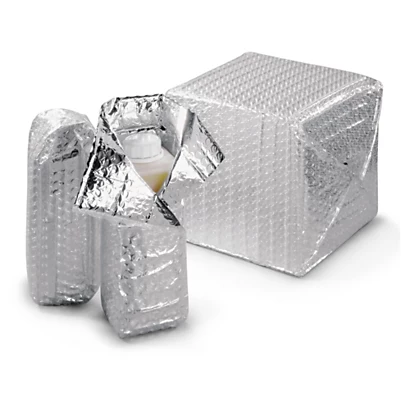 |
Isothermal bubble wrap offers a high level of protection, keeping your products at the right temperature during temperature-controlled transport. |
Temperature indicators
To ensure that the desired temperatures are maintained during the transport of your goods, be sure to add temperature indicators to your packaging.
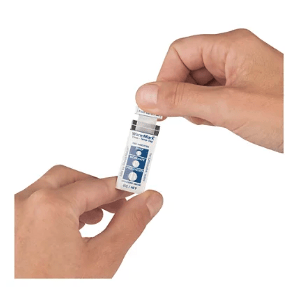 |
The WARM allows you to check whether your parcel has been exposed to temperatures higher than the desired ones. |
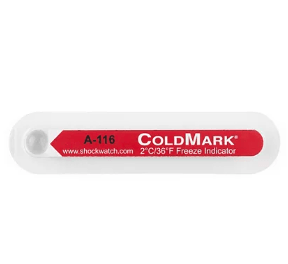 |
The COLD temperature indicator lets you know if your parcel has been exposed to temperatures below the desired temperatures, which could lead to freezing. |
Bags for your last-mile deliveries
If you plan to deliver your fresh produce locally, using bike couriers or cargo bikes, be sure to equip them with the following delivery bags.
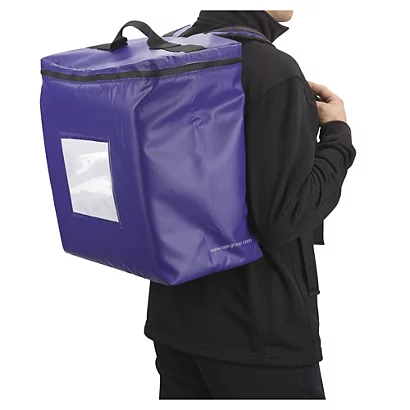 |
The isothermal delivery backpack keeps all foodstuffs perfectly at temperature for between 3h and 5h depending on the type of product (3h for chilled products, 5h for frozen products). |
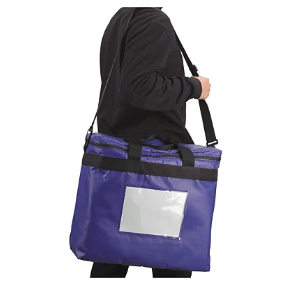 |
The isothermal delivery bag is also available as a shoulder bag, with the same features as the backpack. |
You now have all the knowledge you need to ensure optimum refrigerated deliveries for your products, with a focus on safety and the customer experience.











